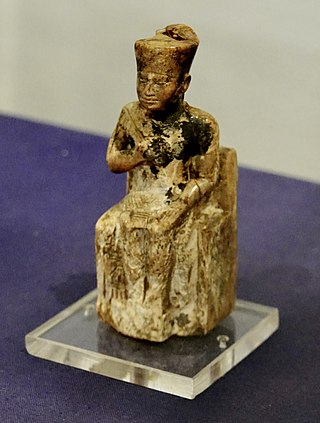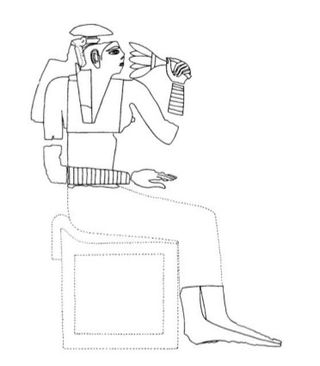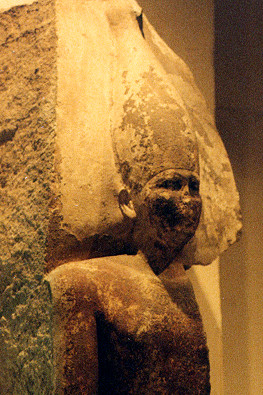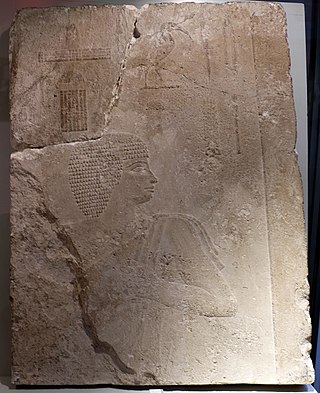
Khufu or Cheops was an ancient Egyptian monarch who was the second pharaoh of the Fourth Dynasty, in the first half of the Old Kingdom period. Khufu succeeded his father Sneferu as king. He is generally accepted as having commissioned the Great Pyramid of Giza, one of the Seven Wonders of the Ancient World, but many other aspects of his reign are poorly documented.

Hetepheres II was a Queen of Ancient Egypt during the 4th Dynasty.

The Fourth Dynasty of ancient Egypt is characterized as a "golden age" of the Old Kingdom of Egypt. Dynasty IV lasted from c. 2613 to 2494 BC. It was a time of peace and prosperity as well as one during which trade with other countries is documented.

The Giza pyramid complex in Egypt is home to the Great Pyramid, the Pyramid of Khafre, and the Pyramid of Menkaure, along with their associated pyramid complexes and the Great Sphinx. All were built during the Fourth Dynasty of the Old Kingdom of ancient Egypt, between 2600 and 2500 BC. The site also includes several temples and cemeteries and the remains of a workers' village.

Hetepheres I was a queen of Egypt during the Fourth Dynasty of Egypt who was a wife of one king, the mother of the next king, the grandmother of two more kings, and the figure who tied together two dynasties.

Sneferu, well known under his Hellenized name Soris, was the founding pharaoh of the Fourth Dynasty of Egypt during the Old Kingdom. Estimates of his reign vary, with for instance The Oxford History of Ancient Egypt suggesting a reign from around 2613 to 2589 BC, a reign of 24 years, while Rolf Krauss suggests a 30-year reign, and Rainer Stadelmann a 48-year reign. He built at least three pyramids that survive to this day and introduced major innovations in the design and construction of pyramids.

Queen Meresankh III was the daughter of Hetepheres II and Prince Kawab and a granddaughter of the Egyptian pharaoh Khufu. She was the wife of King Khafre.
Meritites I was an ancient Egyptian queen of the 4th Dynasty. Her name means "Beloved of her Father". Several of her titles are known from a stela found at Giza. She was buried in the middle Queen’s Pyramid in Giza.

Kawab is the name of an ancient Egyptian prince of the 4th Dynasty. He was the eldest son of King Khufu and Queen Meritites I. Kawab served as vizier and was buried in the double mastaba G 7110–7120 in the east field which is part of the Giza Necropolis.
Khufukhaf I was an ancient Egyptian prince and vizier of the 4th Dynasty.

Duaenhor was a Prince of Egypt. He was named after god Horus.

Mindjedef was a Prince of ancient Egypt, who lived during the 4th Dynasty. His name means "Enduring Like Min". Min is an Egyptian fertility god.

Meresankh II was a Queen of Egypt who lived during 4th Dynasty.
Duaenre was a vizier under Menkaure during the Fourth Dynasty of Egypt. His titles include those of king's son of his body, hereditary prince, count, vizier (tAjtj), scribe of the divine book, mouth of Nekhen, and mouth of every Butite.
Nebty-tepites was a Princess of ancient Egypt. She is mentioned in the tomb of her mother, Meresankh II.

Horbaef was an ancient Egyptian prince of the 4th Dynasty. His title was "King’s son".

Meritites II or Meritites A was a 4th Dynasty princess of ancient Egypt, probably a daughter of King Khufu. She may have been a daughter of Meritites I based on the fact that this queen is mentioned in mastaba G 7650. She married the Director of the Palace, Akhethotep, and she had several children with her husband. Meritites and her husband shared a mastaba G 7650 in Giza.
Hemetre (Hemetra) was an ancient Egyptian royal woman of the Fourth Dynasty. Hemetre may have been a daughter or granddaughter of Khafre. She did not hold the title king's wife and may have even married a non-royal. She is mainly known from her tomb, which is located in the central field of Giza. Her name honors the god Ra.
Nefertkau III was an ancient Egyptian princess. She lived during the 4th Dynasty. She was possibly a daughter of Meresankh II and Horbaef. If so, she was a granddaughter of King Khufu. Baud has proposed that Nefertkau was a daughter of Khufu instead. Nefertkau has the titles King's daughter of his body and Priestess of Neith in a scene in the chapel of her tomb. She was married to an official named Iynefer. Nefertkau and Iynefer had a daughter also called Nefertkau and two or three sons. Strudwick has suggested that Iynefer may be a son of Khufu. Depending on the interpretation of the family relationships Nefertkau may have married either her uncle or her brother.

The East Field is located to the east of the Great Pyramid of Giza and contains cemetery G 7000. This cemetery was a burial place for some of the family members of Khufu. The cemetery also includes mastabas from tenants and priests of the pyramids dated to the 5th and 6th Dynasty.












